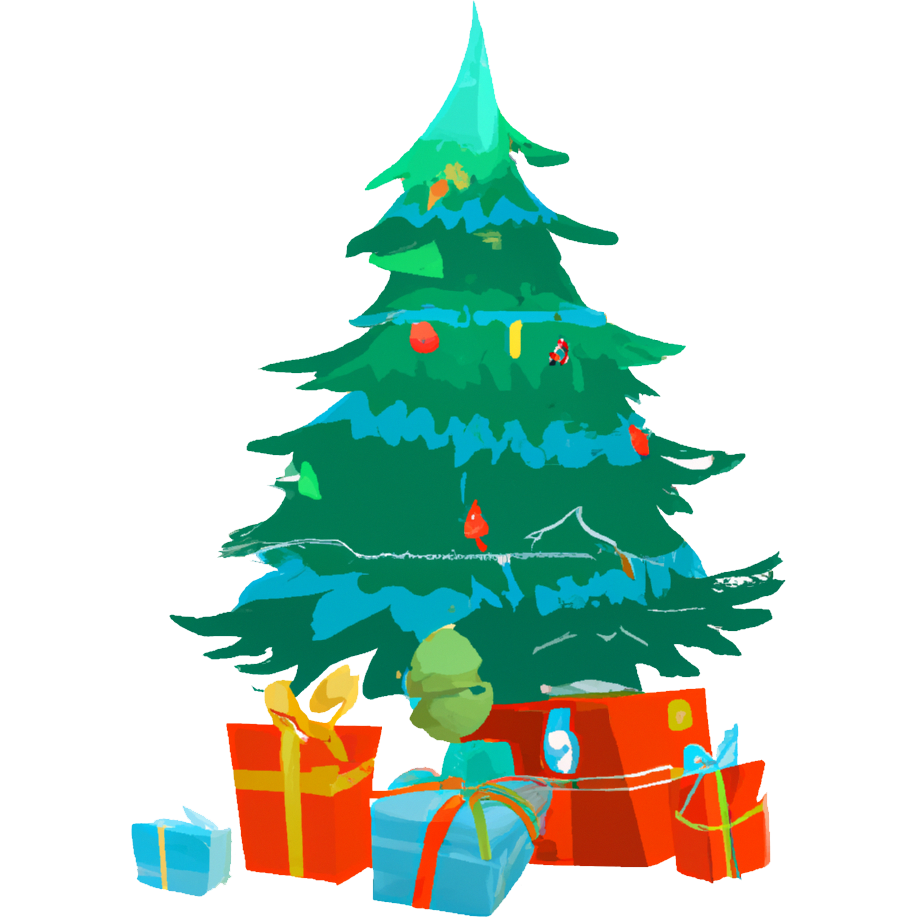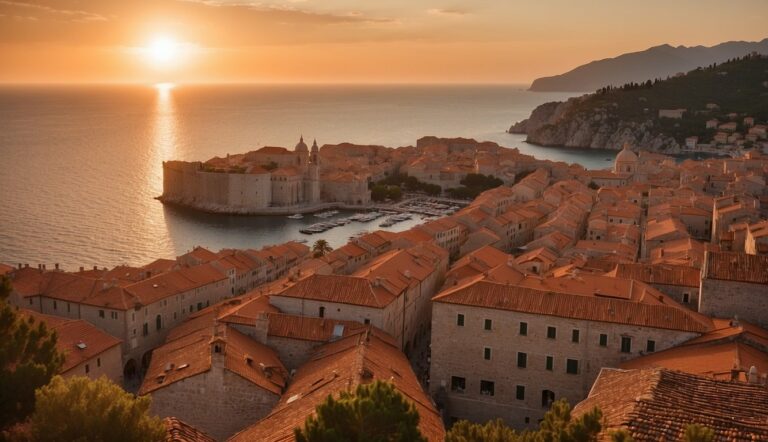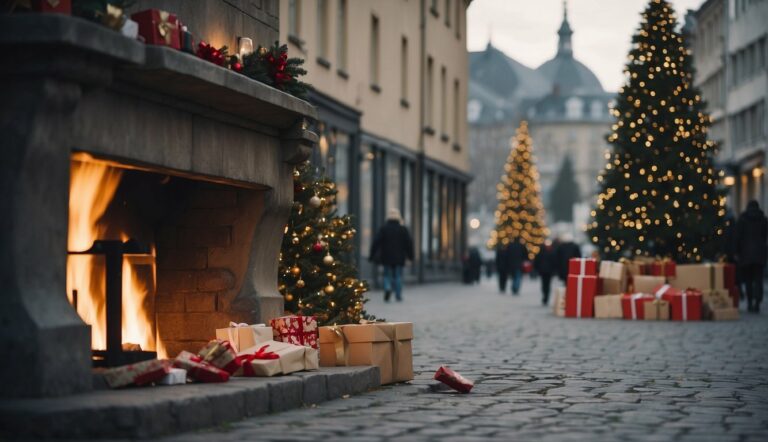Christmas in France: Celebrating Christmas The French Way
Christmas in France is a celebration rich in tradition and cultural nuance, reflecting the country’s deep historical roots and the regional variations across its landscape.
The holiday is recognized as a public holiday on December 25, mirroring global Christian celebrations.
French festivities are known for their blend of solemnity, joy, and gastronomic excellence, where family and communal gatherings underscore the sense of togetherness and shared heritage.
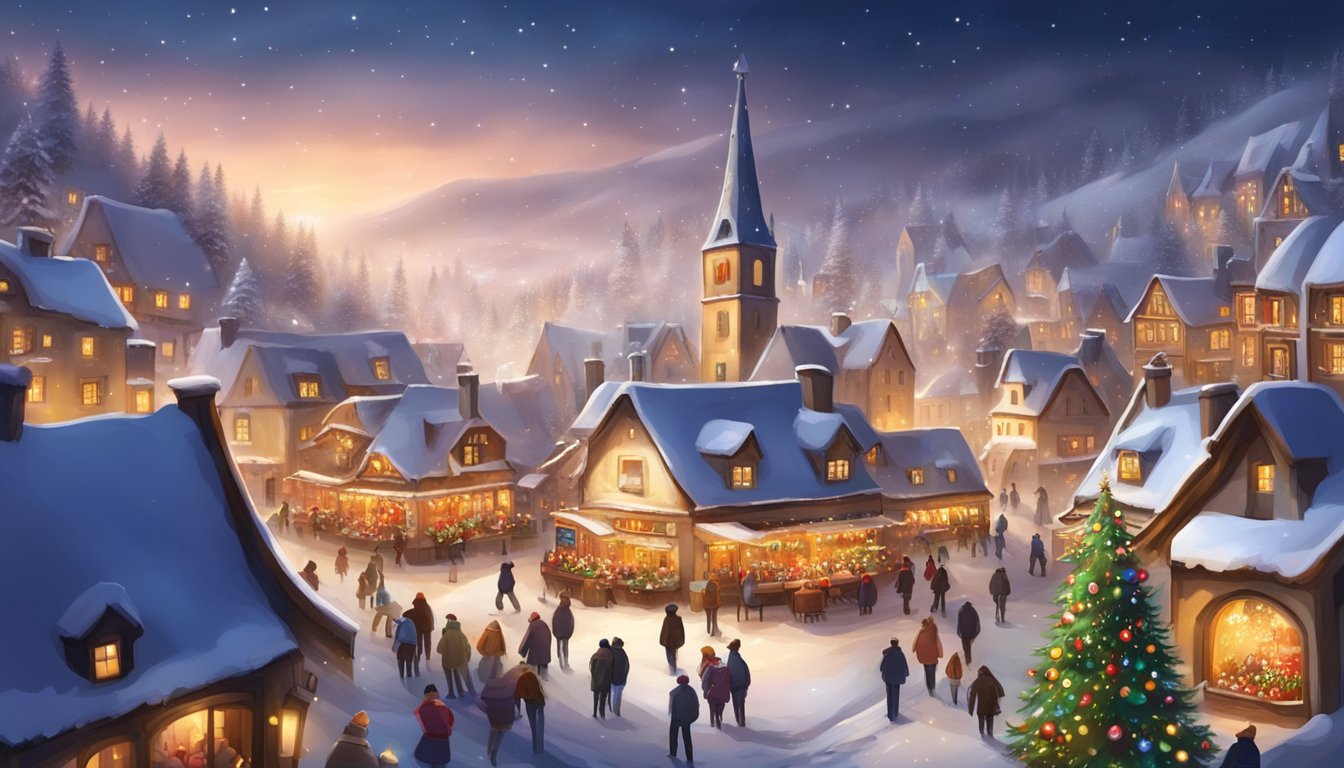
The country’s seasonal markets and the culinary delights that accompany the holiday are essential to the French Christmas experience.
The bûche de Noël, a log-shaped cake symbolizing the yule log, is a crowning feature of the Christmas meal.
Meanwhile, beautifully adorned public spaces and private homes display the festive spirit, with the crèche—nativity scene—taking centre stage in many households.
Handcrafted figurines known as santons are often key in these displays, and they are especially revered in regions like Marseille and Aix.
As evening falls on Christmas Eve, families across France come together for Le Réveillon, a sumptuous and lengthy dinner that heralds the start of the holiday.
This repast, which can last well into the night, is a testament to France’s commitment to tradition and the pleasures of the table.
From the meticulous preparation of dishes to the friendly rounds of toasting, the nuances of Christmas in France are a vibrant tapestry woven from the threads of history, culture, and contemporary celebration.
Historical Origins of Christmas in France
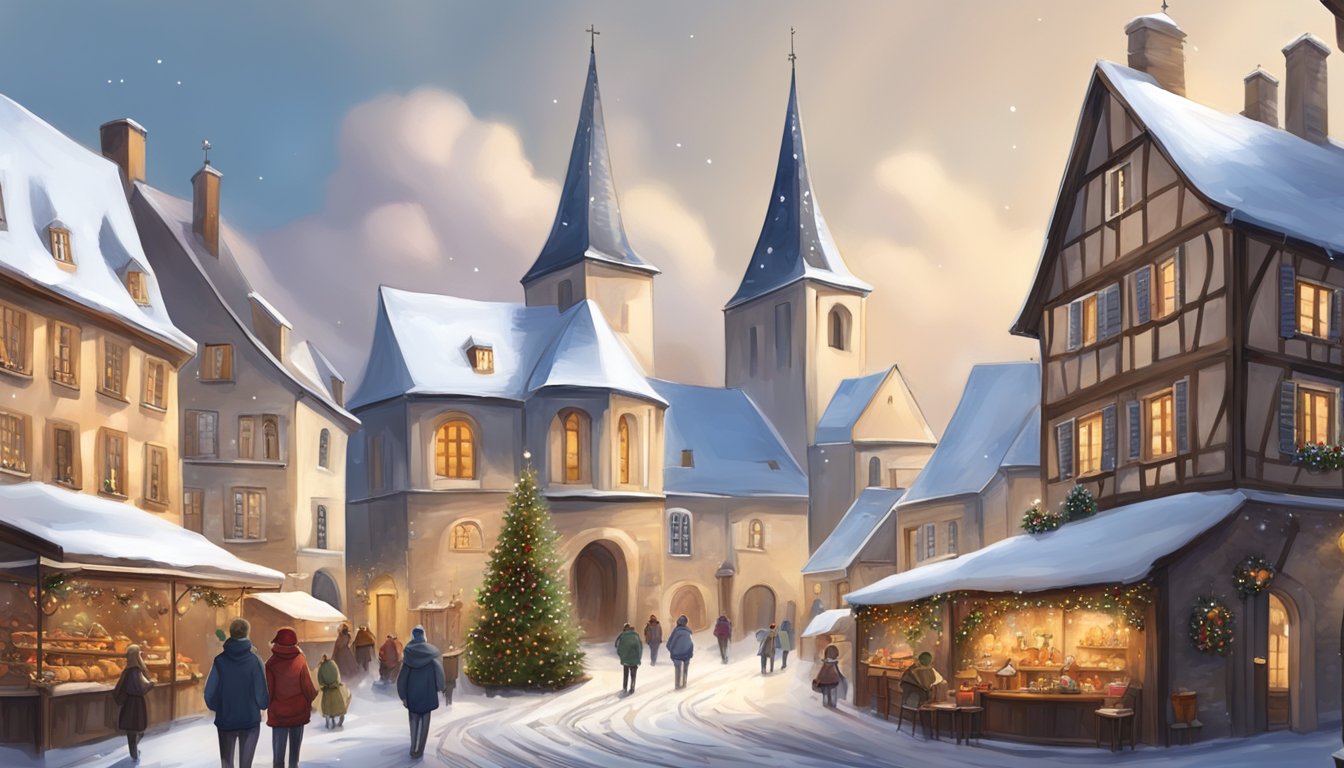
The festive season in France has evolved through a coming together of historical practices from the Advent season, the incorporation of pagan traditions, and the defining influence of Christianity shaping the country’s distinctive Christmas traditions.
The Advent Season
Advent marks the beginning of the Christmas season in France, traditionally starting on the fourth Sunday before Christmas Day.
This period of anticipation involves preparing for the celebration of the birth of Jesus.
Advent calendars and wreaths are popular in France, with each day bringing the French closer to Noël.
Influence of Pagan Traditions
Long before Christianity, the winter solstice was celebrated in Gaul (modern-day France). Festivals of light and giving gifts during the darkest days of winter were customary, marking the end of the year and the return of longer days.
These customs persisted and later intertwined with Christian traditions, influencing festivities such as the yule log, a symbol of warmth and light, and eventually became the Christmas celebrations in France we see today.
The Role of Christianity
Christianity added layers of religiosity to the existing winter celebrations.
Christmas, the celebration of Jesus Christ’s birth, became a cornerstone event.
Churches across France hold Midnight Mass on Christmas Eve, celebrating with nativity scenes, crèches, and special hymns.
Through time, these Christian rituals have become inseparable from French Christmas traditions, shaping the cultural fabric of Noël in France.
French Christmas Symbols and Decorations
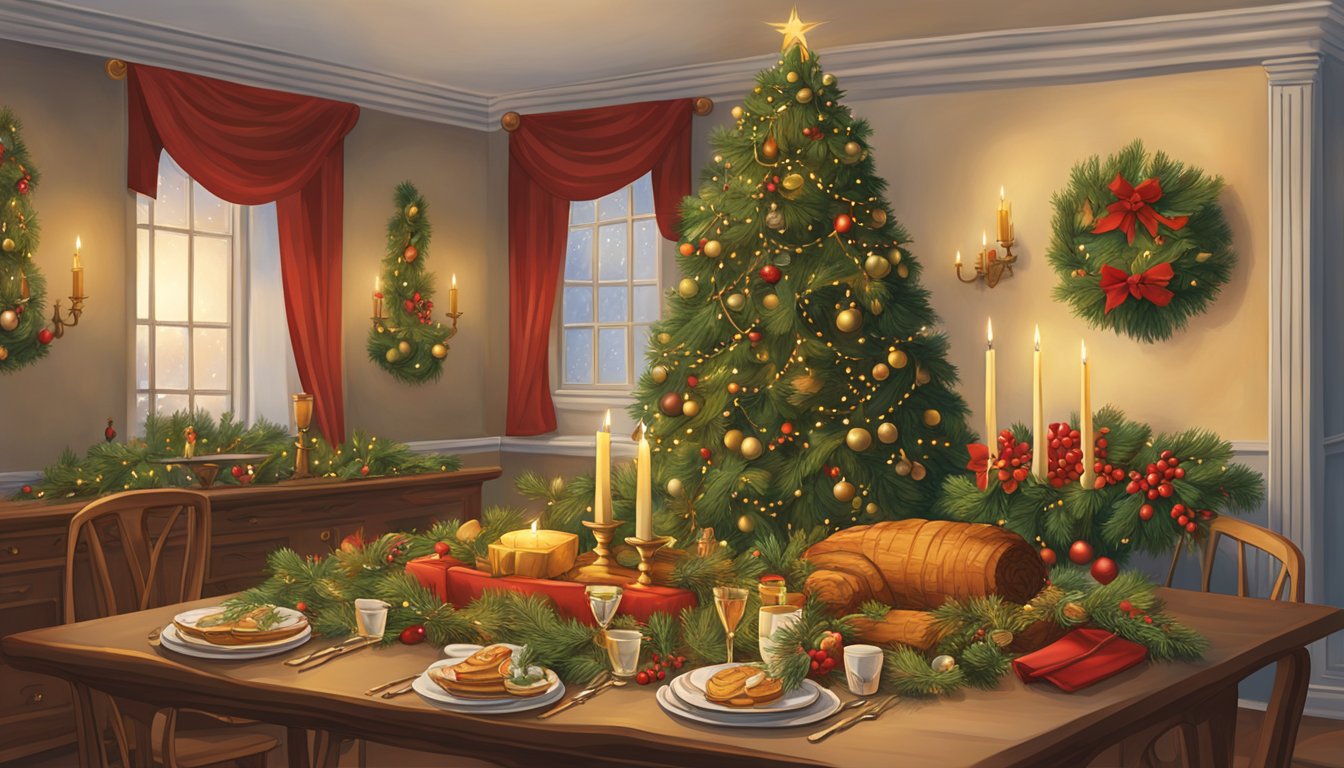
In French Christmas tradition, symbols such as the Christmas tree and Nativity scenes play a central role, while decorations like lights and ornaments add a festive touch to the holiday.
The Christmas Tree
The Christmas tree, or sapin de Noël, is a focal point in French Christmas celebrations.
Families across France choose either real fir trees or artificial alternatives to embellish their homes.
A notable tradition involves decorating the Christmas tree together, fostering unity and joy among loved ones.
French families typically adorned their trees with:
- Christmas Baubles (Boules de Noël)
- Tinsel (Guirlande)
- Candles (Bougies)
- A distinctive Christmas tree topper
Nativity Scenes
Nativity scenes are a heartfelt representation of the biblical account of Jesus’ birth and are significant in French Christmas customs.
These scenes, known as crèches, often feature hand-painted figurines representing the Holy Family, shepherds, and the Wise Men.
Regions renowned for their crèches include:
Provence: Famous for its Santons, little saints, traditionally handcrafted terracotta figures.
Alsace: Known for intricate, ornate displays reflecting the region’s deep-rooted Christmas traditions.
Lighting and Ornaments
Christmas lights and a variety of ornaments illuminate French cities and homes, creating a magical atmosphere during the festive season.
Streets twinkle with elaborate light displays, and shop fronts are decorated with wreaths and festive embellishments.
Residential decorations often include:
- Indoor lighting schemes featuring fairy lights.
- Outdoor spaces adorned with luminous wreaths and garlands.
- Candles reflect the spirit of warmth and friendliness that pervades Christmas in France.
Culinary Delights of French Christmas
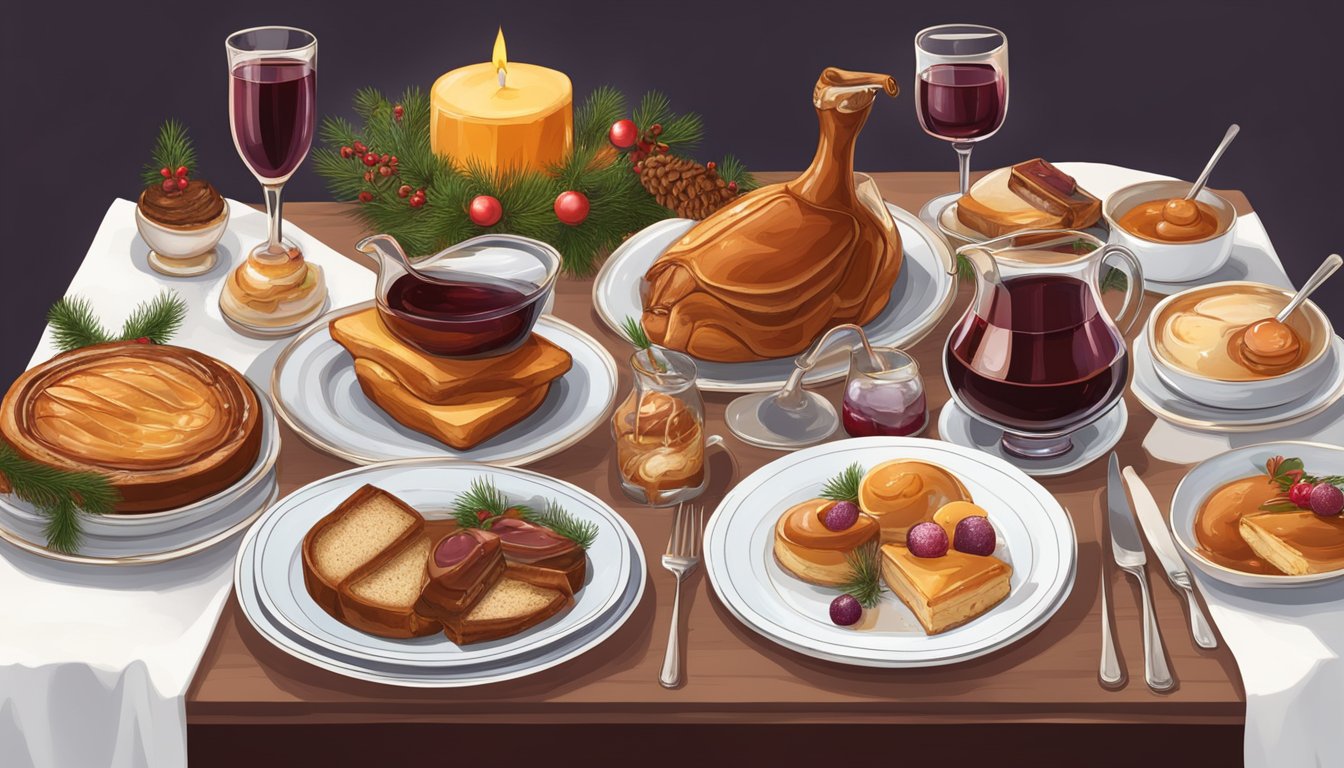
The French Christmas is renowned for its gastronomic excellence, with traditional meals and desserts that embody the festive spirit. The culinary experience is integral to Noël, showcasing rich flavours and elegant presentations.
Traditional Christmas Eve Dinner
On Christmas Eve, families in France gather for a grand meal known as Le Réveillon.
This Christmas dinner often features luxurious dishes such as foie gras, oysters, and various types of seafood.
A common centrepiece is a turkey stuffed and roasted perfectly, often served with chestnuts.
Truffles and caviar add a touch of luxury to the celebration.
Accompanied by fine French wines and champagne, the Réveillon meal is an elaborate prelude to the gift-giving that traditionally follows at midnight.
The 13 Desserts of Provence
In Provence, a special tradition called “Les Treize Desserts de Noël” marks the end of the meal on Christmas.
These 13 desserts represent Jesus and his 12 apostles, each item having its own symbolism. The desserts usually include:
- Nuts and Dried Fruits: Figs, almonds, raisins, and dates.
- Fruit: Quince paste or candied fruits.
- Pastries: Madeleines, calissons, and nougat.
The presentation and selection vary, but they always total thirteen, reflecting the regional pride in their unique Christmas heritage.
Festive Foods and Confections
Throughout the festive period, several treats are savoured.
The iconic bûche de Noël, a sponge cake fashioned into a Yule log, is a sweet mouthpiece of the French Christmas.
It often has chocolate or chestnut filling.
The Galette des Rois is another festive delicacy, a flaky pastry cake traditionally eaten during Epiphany in January but also enjoyed throughout the Christmas season.
Festive Activities and Markets
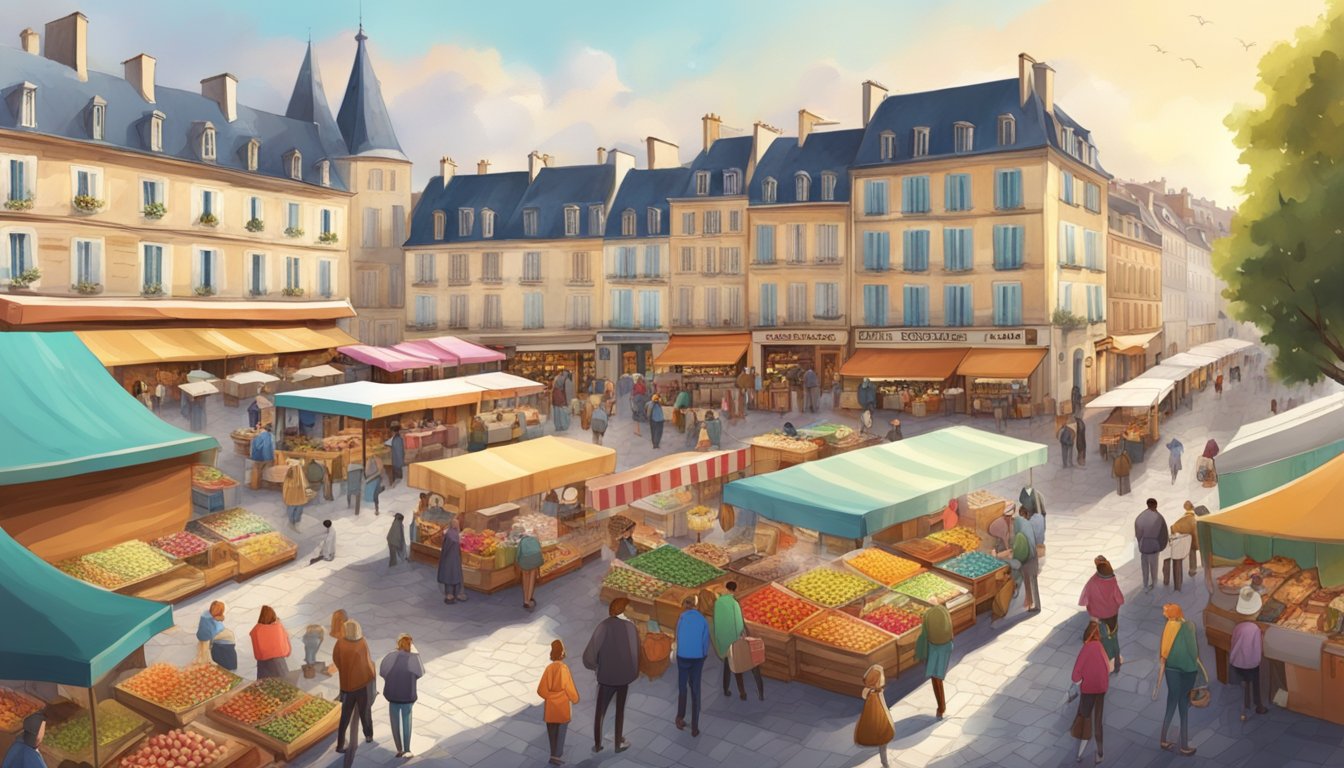
The holiday season in France is marked by a vibrant array of Christmas markets and festive activities that draw visitors from around the world. Each region boasts its own traditions, while Paris provides a glamorous seasonal backdrop that complements the local celebratory customs.
Regional Christmas Markets
Alsace, particularly Strasbourg, is famous for its Christkindelsmärik, the oldest Christmas market in France, dating back to 1570.
Visitors can browse through numerous stalls offering traditional Alsatian Christmas decorations, regional crafts, and seasonal treats such as Bredele biscuits and hot mulled wine.
Strasbourg is home of the Christkindelsmärik market, admired for its illuminated Christmas tree and festive booths.
Colmar is known for its picturesque half-timbered houses and canals, creating a storybook setting for the holidays.
Sélestat holds a special place in Christmas history as the site of the first recorded Christmas tree in 1521.
In the north, cities like Lille and Arras host their markets, each with a distinct feel.
Lille’s market is recognized for its Ferris wheel and regional products, while the Arras market, set in the town’s historic square, features a towering Christmas tree and ice skating rink.
Christmas Celebrations in Paris
During Christmas, Paris transforms into a city of enchantment.
The Eiffel Tower and Galeries Lafayette become focal points of the festivities, with the latter fashioning a must-see holiday window display.
Tuileries Christmas Market offers a mix of shopping, food stalls, and carnival rides in the heart of the city.
La Défense Christmas Village is the largest market in the region, with over 300 exhibitors.
Not to be outdone, the Christmas windows of department stores like Printemps and Galeries Lafayette captivate crowds with their whimsical animations and dazzling designs.
Provencal Festivities
Provence celebrates Noël with a distinctive flare that reflects its cultural heritage.
The region’s markets are filled with santons, traditional handcrafted clay figurines representing the nativity, and often feature living nativity scenes.
Santons are unique to Provencal Christmas markets. These small figurines are a collector’s delight.
Foire aux Santons happens in various towns across Provence, with Marseille being a notable location.
In addition, Provencal festivities are incomplete without the grand Gros Souper feast on Christmas Eve, followed by the Pastrage ceremony, which involves a shepherd bringing a lamb to the church to honour the birth of Jesus.
Christmas Folklore and Characters
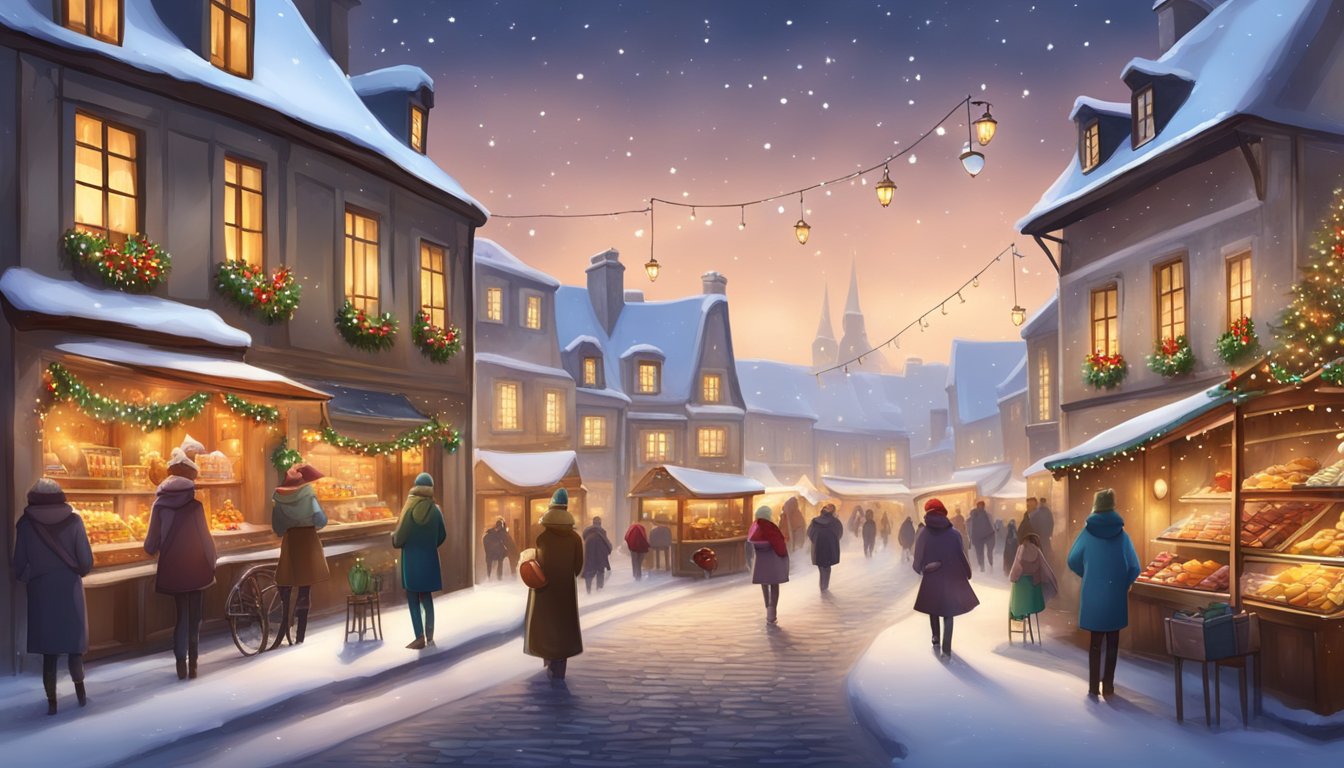
In France, the Christmas season is enriched by a cast of characters from folklore who bring their own stories and customs to the festive period. These figures are integral to the cultural celebrations and hold a special place in the hearts of those who partake in the Yuletide spirit.
The Legend of Santa Claus
The image of Santa Claus, or Father Christmas, as he is known in many parts of the world, is a cornerstone of Christmas folklore globally. He is associated with bringing gifts to children on Christmas Eve in France.
Children traditionally leave their shoes by the fireplace or under the Christmas tree hoping they will be filled with presents by morning.
Tales of Père Noël
Père Noël, the French interpretation of Santa Claus, plays a similar role in delivering gifts. On Christmas Eve, the children put out a plate of cookies and a glass of milk for Père Noël as a thank you for the presents he leaves.
His outfit is often illustrated as a long red cloak with a matching hat and a sack filled with gifts over his shoulder.
Père Fouettard and Other Figures
Accompanying Père Noël is a less jolly figure named Père Fouettard. He is said to accompany Père Noël to deal with children who have misbehaved throughout the year.
His depiction varies, but often, he carries a bundle of twigs as a symbol of the punishment he can administer. Despite his ominous presence, French Christmas focuses on celebration, gift-giving, and family.
Religious Observances and Practices
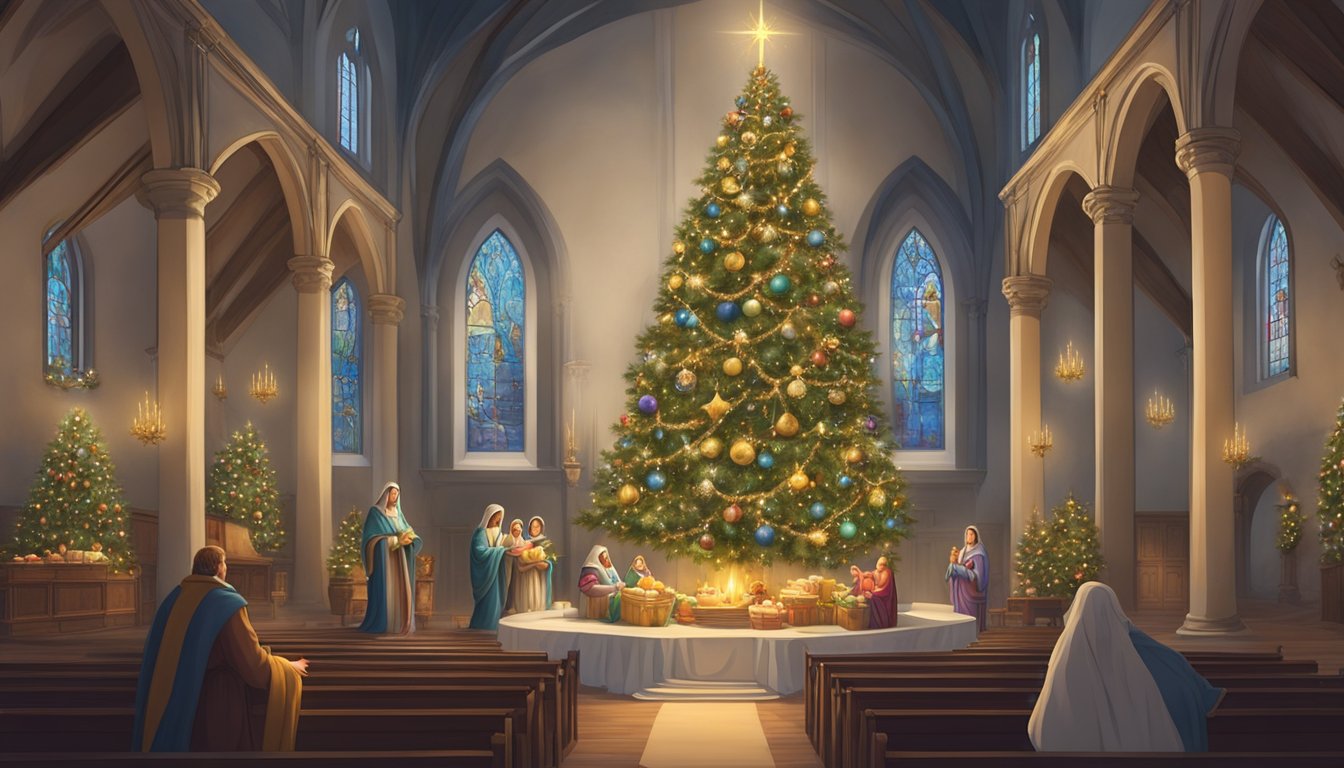
In France, Christmas is a religious holiday steeped in tradition. Specific observances mark the Advent season, culminating in the Nativity.
Churches play a central role, hosting Midnight Masses and Epiphany celebrations, reflecting France’s enduring Catholic heritage.
Attending Midnight Mass
Midnight Mass, known as la Messe de Minuit, is a quintessential Christmas practice in France. On December 24th, families gather in churches such as the iconic Sacré-Cœur Basilica in Montmartre to celebrate the birth of baby Jesus through traditional Catholic liturgy.
The sound of carols fills the air, fostering a communal spirit of worship.
Observance of Epiphany
The Epiphany, falling on January 6th, marks the end of the Christmas season in France. It commemorates the visit of the Magi to the infant Jesus, symbolizing Christ’s physical manifestation to the Gentiles.
Churches conduct special services, and families celebrate with a Galette des Rois or King’s Cake eaten in honour of the Epiphany.
Advent Wreaths and Calendars
During Advent, the anticipation of Christmas is marked by two main symbols:
Advent Wreaths, comprising four candles, represent the four weeks of Advent. One candle is lit each week leading up to Christmas.
Advent calendars are popular among children and adults alike, counting down the days to Christmas, each day uncovering a small gift or chocolate, ending on December 24th.
Both Advent wreaths and Advent calendars serve as daily reminders of the approaching celebration of the Nativity and the arrival of Jesus.
Modern Christmas Celebrations in France
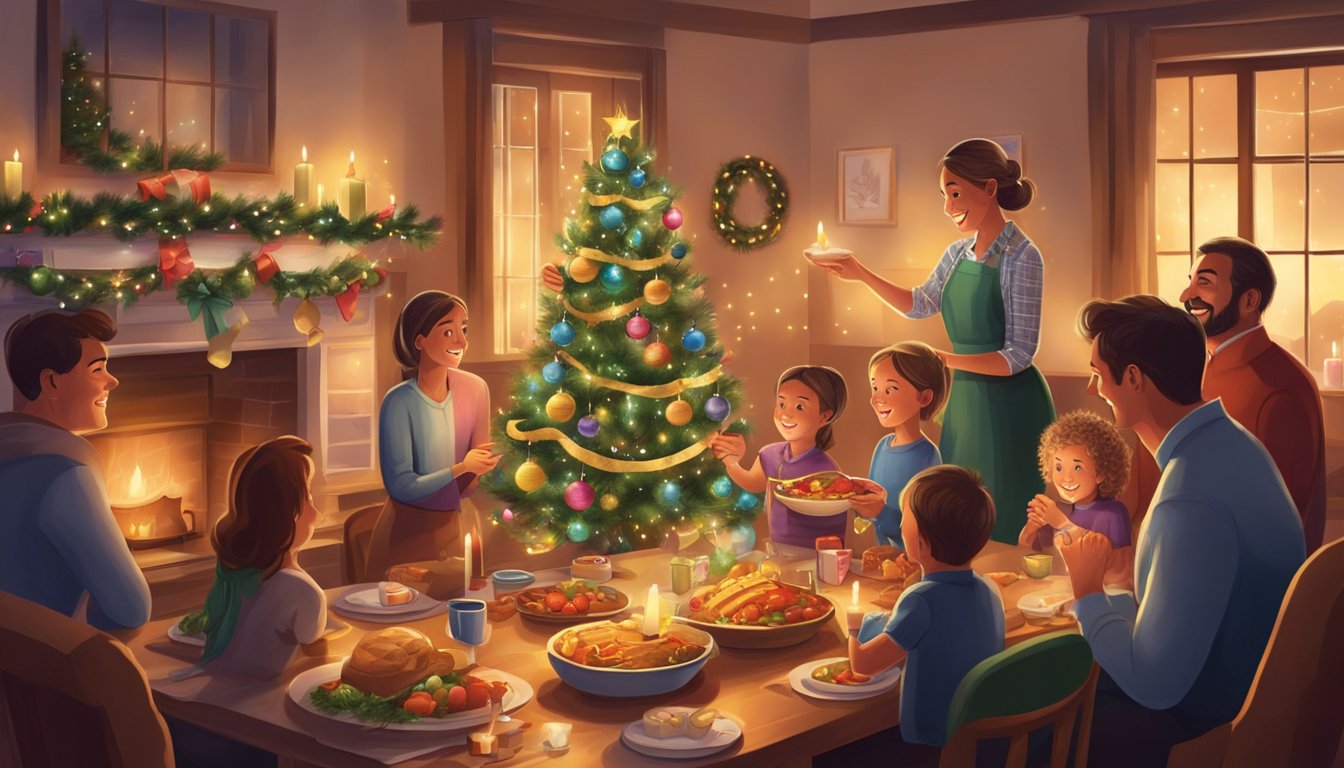
In France, Christmas is a time of togetherness where families indulge in traditions and cities sparkle with festive splendour.
Gifts are exchanged, cities are adorned with lights, and joyous events mark the festive period.
Gift Giving and Family Gatherings
The exchange of presents is a central part of Christmas celebrations in French households. During Réveillon on Christmas Eve, families gather for a lavish dinner before exchanging gifts.
Culinary delights often include delicacies like foie gras, oysters, and the bûche de Noël (Yule log cake), symbolizing the tradition’s richness.
Christmas in French Cities
Paris, known as the “City of Light,” transforms into a magical winter landscape with streets lined with twinkling lights and decorations.
Lesser-known yet equally mesmerizing is the city of Nancy, which hosts the Saint Nicolas parade, showcasing the region’s festive spirit.
These urban centres become hubs of celebrations, inviting locals and tourists alike to revel in the holiday atmosphere.
Public Displays and Events
Public squares and streets across France showcase intricate Christmas illuminations and nativity scenes.
The sound of church bells on Christmas Eve is common, with the Midnight Mass being a notable event many attend following the traditional feast.
Additionally, markets and outdoor events spread the season’s joy, offering various festive crafts, foods, and activities.
French Christmas Cuisine Specifics
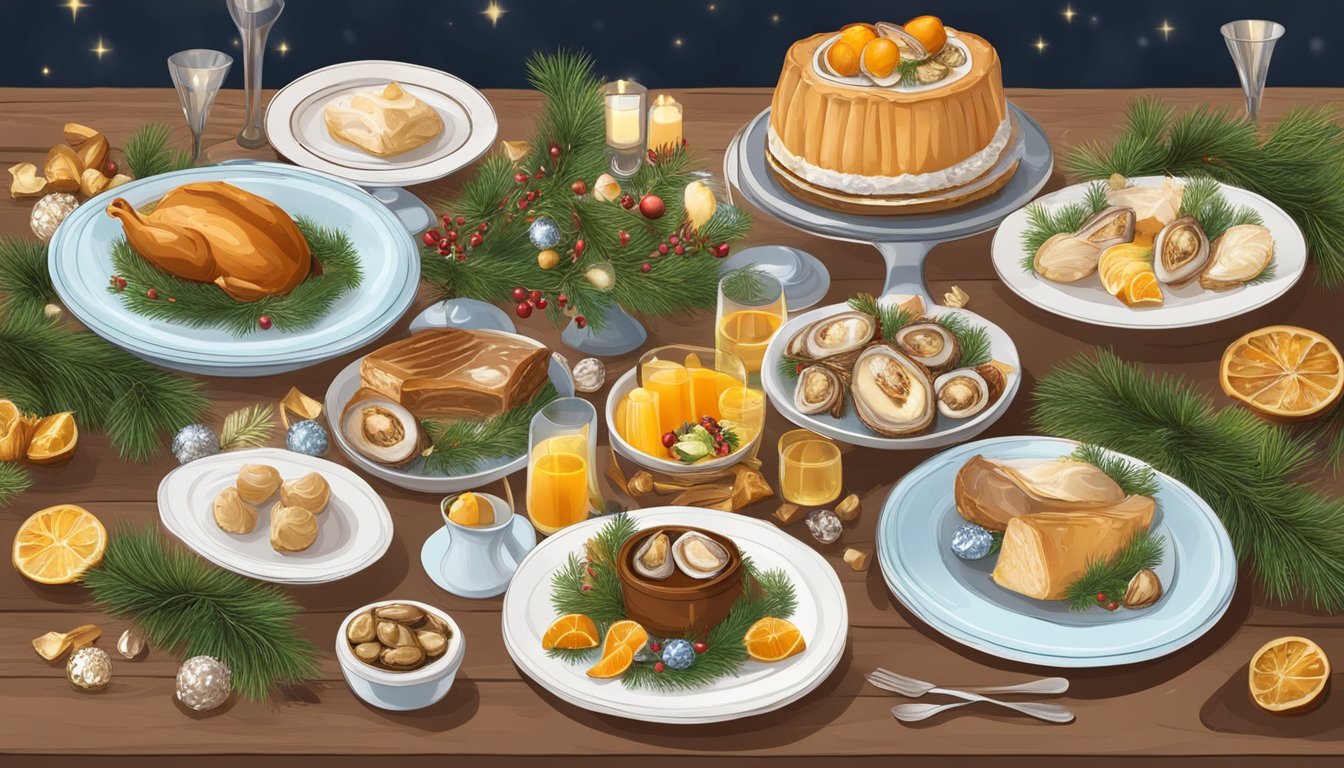
French Christmas cuisine uses luxurious ingredients and traditional dishes that vary by region. During the holiday season, especially the réveillon (midnight feast on Christmas Eve), families gather to indulge in an elaborate multi-course meal.
Seafood Traditions
The French often start their Christmas meals with a variety of seafood, with oysters (les huîtres) being particularly popular.
Serving 4 to 6 oysters per person is customary, often accompanied by buttered rye bread and lemon. Other seafood staples include scallops and various types of fish.
Desserts and Baked Goods
Desserts are central to French Christmas traditions, with bûche de Noël, a yule log-shaped cake, taking a special place on the dessert table.
Kugelhopf, a crown-shaped cake from Alsace, and pompe à l’huile, a sweet bread from Provence, are also popular.
Ingredients like almonds, hazelnuts, butter, and different kinds of fruit, including apples, oranges, pears, and dates, are commonly featured.
Christmas Beverages
Beverage pairings are integral to the meal, with champagne often served to toast the occasion.
Mulled wine brings warmth to the festivities with its red wine and spices blend.
The French enjoy wine selections throughout the meal, typically serving white wine with appetizers and red wine with the main course.
Cultural Traditions and Regional Variations
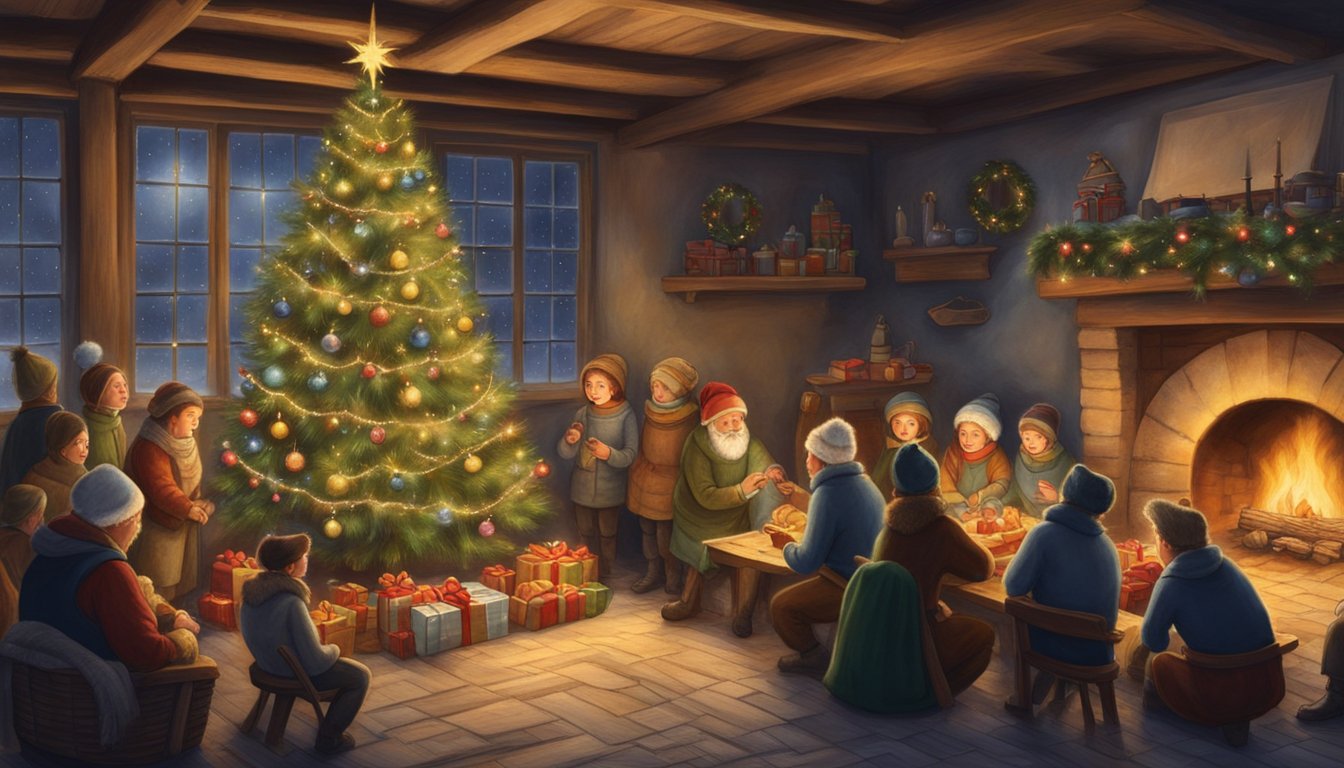
The Christmas season in France is marked by a rich tapestry of customs and traditions, varying significantly from one region to another. Each region has distinct characteristics influenced by historical and geographical factors.
Unique Customs across France
Advent is celebrated with traditional calendars and wreathes across the numerous provinces of France in the lead-up to Christmas.
Brittany and Normandy, for instance, are known for their distinctive Christmas markets and nativities, a tradition that echos the nation’s deeply rooted Catholic heritage.
Celebrations in Alsace and Other Regions
Alsace bears the hallmark of the French Christmas spirit, blending its traditions with Germanic influences due to its proximity to Germany.
Towns in Alsace burst into festive splendour with one of the oldest Christmas markets in Europe, originating in Strasbourg. This region is also famous for its elaborate nativities and Advent decorations.
Influence of Neighboring Countries
France’s proximity to other countries, like Germany, has led to a cultural exchange that enriches the French Christmas experience.
The use of Advent calendars and wreaths, as well as the elaborate staging of nativities, are traditions that have crossed borders, thereby diversifying the local Christmas customs within regions close to Germany.
Frequently Asked Questions
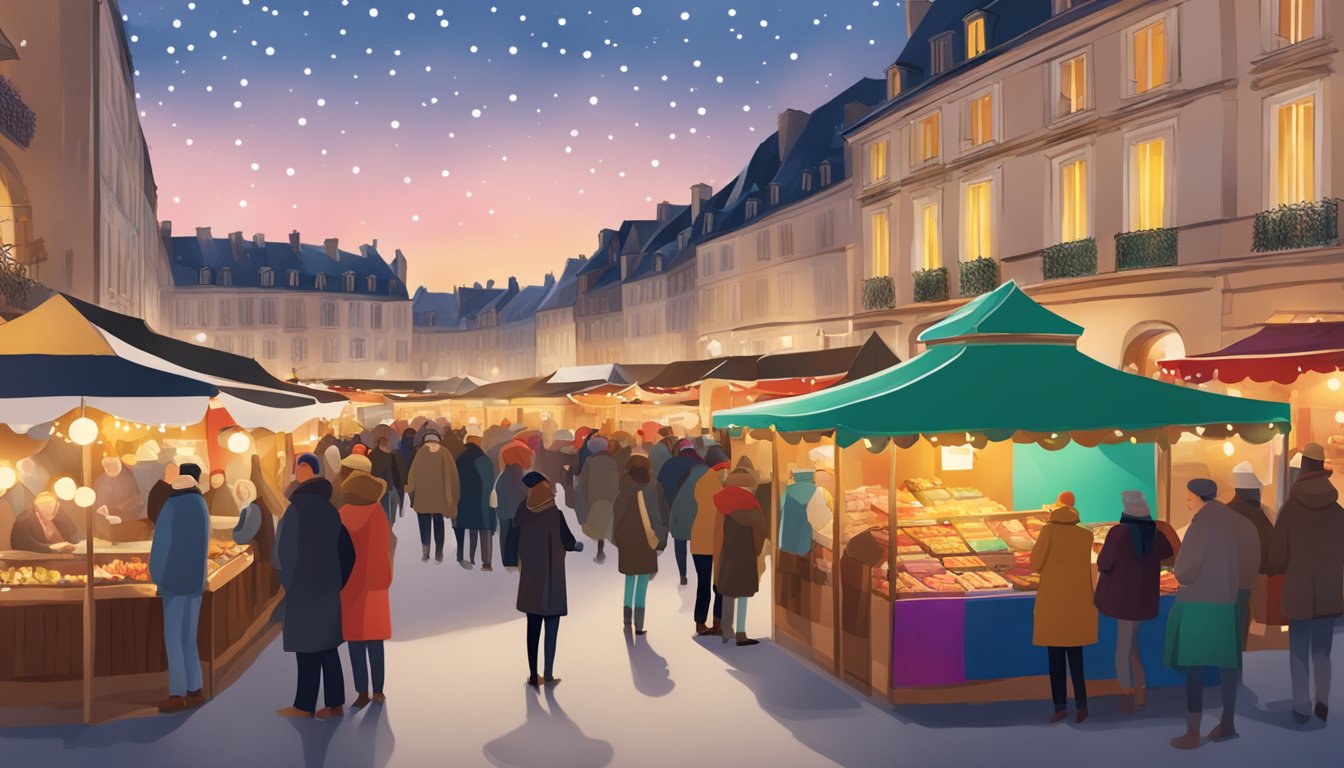
What are some traditional customs observed during Christmas in France?
France observes Advent with traditions, including lighting candles on the Advent wreath leading up to Christmas. Decorated Christmas trees are common, and many families display intricate Nativity scenes, often with figurines called ‘santons’.
How do French celebrations of Christmas differ from American traditions?
French Christmas is less commercial and more focused on food, family, and tradition. While Americans may emphasize Christmas Day, the French often celebrate Christmas Eve with a late-night dinner known as ‘Le Réveillon’ after attending Midnight Mass.
What are typical dishes served during Christmas in France?
Christmas in France is synonymous with gourmet dining. Traditional dishes include roasted meats, ‘foie gras’, oysters, and the ‘bûche de Noël’ for dessert. The ‘bûche de Noël’ is a log-shaped cake symbolizing the Yule log previously burned centuries ago.
Can you describe typical Christmas festivities for children in France?
French children eagerly anticipate the arrival of ‘Père Noël’ (Father Christmas), who brings presents on Christmas Eve. In the lead-up to Christmas, they enjoy Advent calendars. Some regions also celebrate Saint Nicholas’ Day on December 6th.
What historical events have shaped Christmas traditions in France?
Queen Marie Leszczyńska introduced the first Christmas tree at the Chateau of Versailles in 1738. Historical events have consistently moulded French Christmas traditions, incorporating Christian symbolism and regional cultural practices.
What are some notable facts about Christmas celebrations in France?
One notable fact is that France’s first documented Christmas tree appeared in 1521.
Christmas markets, originating in Alsace, are also a quintessential feature of the season. Strasbourg hosts one of the oldest and most famous markets in Europe.
